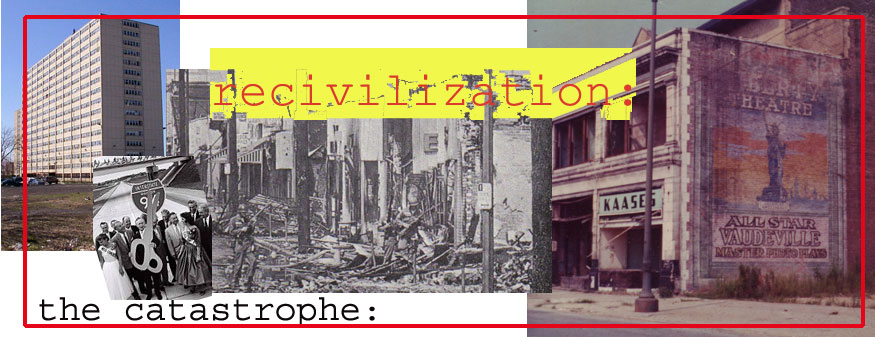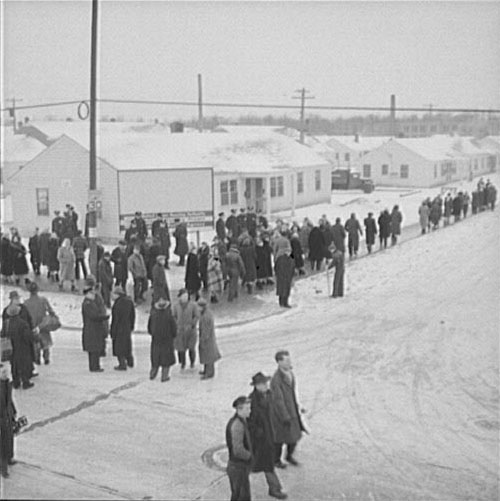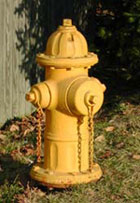

315 the northern jim crow
White neighbors demonstrating against blacks living in the Sojourner Truth Homes, Detroit, 1942, just before the riot.
Everybody's for the underdog...long as he stays the underdog It was just what the northern cities needed in tough times-the sudden arrival of two million more southern blacks, many of them sharecroppers or tenant farmers who had been beaten down for generations since the Civil War, many with no experience of life as citizens, no job skills, and no idea of what life in a modern city requires. The second, and biggest wave of the Great Migration began during the war and continued through the 50's and 60's. A nation that had just fought a war for democracy and freedom was not about to return to business as usual regarding blacks. The beginnings of the civil rights push came right after victory, and the opening acts of the drama took place in the nation's capital, a stronghold of segregation, where weeks of picketing failed to integrate the National Theatre or the city's pools and playgrounds. President Truman did his level best to set an example, in Washington and the nation as a whole, ending segregation in District employment at the same time his administration commanded it in the armed forces and all federal agencies. Similar battles would go on all through the 50's and 60's. Most of the headlines, as expected, came from the South, with the epic civil rights marches, the sit-ins and freedom rides, the truncheons, bombs, bullets and fire hoses of the segregationists. Northerners could sit back and read them with smug self-satisfaction; on the whole they paid little mind to the complementary struggles going on right in their backyards. By 1960, more than seven million blacks lived outside the South, mostly in northern cities. They had problems of their own: bad, segregated schools, job discrimination, neglect from city hall and rough treatment from the police. And they marched and protested against them just as blacks down south were doing. One issue overshadowed all the others. In housing, nothing had changed since the early days of the Great Migration; if anything, cities had perfected their methods of containing blacks. Within the ghettos, the new arrivals were increasing the pressure to the bursting point. It would be instructive to follow the experience of Chicago. Being Chicago's, the story was noisier than other cities could manage, but it does capture the atmosphere of changing neighborhoods and panicked neighbors familiar in every northeastern city. Chicago received the biggest flood of migrants: from 278,000 in 1940, the black population zoomed to 492,000 in 1950, and 813,000 in 1960. The tradition of racial battles simmered on, but Chicago did try; in fact, in the 40's under Mayor Ed Kelly, the city was far more radical and integrationist than the feds, with their 'neighborhood composition rule'. Kelly's Chicago Housing Authority became a national model, efficient and innovative; its director, Elizabeth Wood, and its black chairman, Robert R. Taylor, adopted a policy of placing blacks in all-white areas-up to a limit of 10%, which was the proportion of blacks in the city's population. Chicagoans weren't ready for it. The lid blew off in the middle of the war. From May 1944 to July 1946, 49 black homes were bombed. An attempt in 1946 to integrate the Airport Homes project on the southwest side led to a sit-in by white mobs on election day, lasting for two weeks until the city retreated. The affair caused the downfall of Mayor Kelly, whom the party commissars replaced with the anti-integrationist Martin Kennelly. The 1948 Supreme Court decision Shelley vs Kraemer, finally declaring restrictive covenants unenforceable, only added to the frantic atmosphere. Chicago's next integration battle came in the Park Forest neighborhood on the south side, with two weeks of rioting in July 1949. Taylor resigned in 1950, ending the attempt to integrate the projects, but neighborhood battles continued. Suburban Cicero, once the fief of Al Capone, had two weeks of rioting in summer of 1951, requiring the intervention of the National Guard. In 1953 a white mob besieged Trumbull Park Homes in the South Deering neighborhood when a few black families were moved in-the siege lasted two years . Throughout the 50's smaller incidents-house bombings and arson, beatings and mob attacks-were too numerous to count. In Detroit, the first big fight over housing came in 1942, with an attempt to introduce blacks into war workers' housing at the ironically named, all-white Sojourner Truth Homes on East Seven Mile Road. Detroit's form of protest was particularly virulent; throughout the 50's 'Homeowners' Associations' dominated much of the city, and mobs threatening blacks, burning crosses and damaging property became everyday occurrences. White paranoia made possible the reign of Republican mayor Albert Cobo, who won four terms with overtly racist campaigns. Detroit even passed a racist-inspired 'Homeowners' Rights Ordinance' by initiative in 1964, three years before the big riot; the courts almost immediately declared it unconstitutional. Race and housing had become the central issues of city politics, but by their nature cities were unable to confront them openly-there weren't any easy answers, or even any hard ones. Some cities did a better job than others; Cleveland had an admirable Community Relations Office that helped greatly in keeping the lid on, but in most towns attempts at mediation and understanding were few. Blacks were squeezed between urban renewal displacements and a violent segregationist wall; whites felt they were being overwhelmed, a setting that made white backlash politics fashionable, and often absolutely necessary for political survival. No one did it better, or more discreetly, than Chicago's Richard Daley, who said as little as possible about the issue and won the mayoralty in 1952 with a big black vote directed against Kennelly. Daley turned the CHA from a model agency into one that was segregationist, patronage-ridden and incompetent. He also kept Chicago from getting an open-housing ordinance until 1963, and then it was so diluted as to be useless. The cornerstone of policy in 'the City that Works' had become containment of blacks, in housing and also in politics. Black elected officials would push black housing issues, so the Chicago machine saw to it there were as few of them as possible. The city did not even have a black Democratic alderman until 1958 (Benjamin Lewis, murdered five years later under mysterious circumstances), and some old white ethnic ward bosses held on into the 70's in black areas. In 1966, Martin Luther King moved the civil rights movement's focus up north, choosing Chicago, and housing and education, for his first targets. Moral necessity may have commanded it, but the campaign would be a turning point: disastrous for the movement, bad for Chicago, and for America as a whole. Neither King, nor any other black leaders, nor many in the media or in the federal government, understood anything of the mentality of the people on the other side of the barricades, mirroring the lack of comprehension and sympathy among whites. Housing in Chicago had become as bitter an issue as anything Northern Ireland could ever produce. White folks who besieged black families sincerely believed they were under siege themselves; many of the residents who threw rocks at King's marchers in Marquette Park or Belmont had already been panicked out of another neighborhood. The arrival of Dr. King inspired other local efforts. In Milwaukee, politicians and newspapers raised the usual denunciations of 'outside activists', but the real troublemaker was a home-grown young white ethnic, Father James Groppi of the northside St Boniface Church. Throughout 1966 and '67, Groppi led his 'commandos' in demonstrations against school and housing segregation, and against the segregated and politically powerful downtown Eagles Club. Riots came a week after Detroit's, a mild, typically Milwaukee, one-day affair with only three fatalities. A month later, Groppi tried to lead a march over the 16th Street bridge into ethnic territory and was beaten back, while the NAACP headquarters was firebombed. Mayor Henry Maier, a well-intentioned man caught in a hard place, acted badly through it all, refusing to consider an open-housing ordinance while his police guarded white demonstrations and assaulted black ones. Father Groppi and his followers marched for 200 straight days, making a big splash on the national TV news, and finally the ordinance was passed. But even in progressive Wisconsin, backlash was guaranteed. In fact it had already happened; the coming death of the New Deal coalition could have been detected in the '64 Wisconsin primary, when George Wallace got a third of the vote, and metalworkers and their wives in the Serb Memorial Hall in Milwaukee welcomed the governor with 'Dixie', sung in Polish. |
|

|